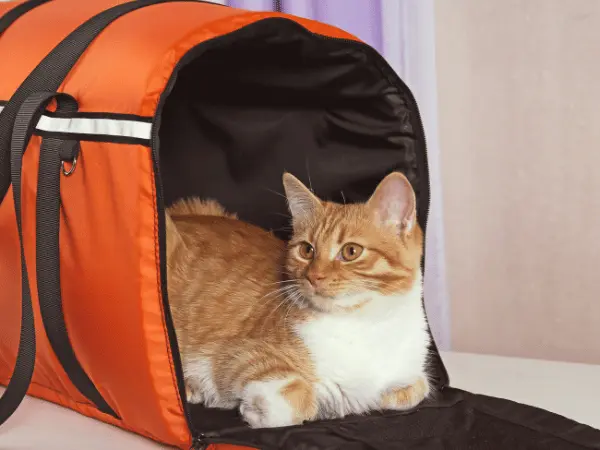Traveling with a cat, whether it’s a short trip or a long-distance journey, requires thoughtful preparation to ensure your feline companion’s comfort and safety. Cats are creatures of habit and can become stressed in unfamiliar environments or radically new situations, so it’s essential to plan ahead for a calm experience.
In this complete guide by Sploot Vets, we’ll go over how to travel with a cat on a plane and by car. Plus, we’ll cover essential tips for traveling with a cat for short trips (like going to the vet) and longer journeys (like road trips or interstate adventures).
What’s In This Guide?
- Are Cats Okay with Traveling?
- How to Travel with a Cat to the Vet, Groomer, & Other Nearby Places
- How to Travel with a Cat by Car [Long & Interstate Journeys]
- How to Travel with a Cat by Plane
- Final Thoughts on Traveling with a Cat
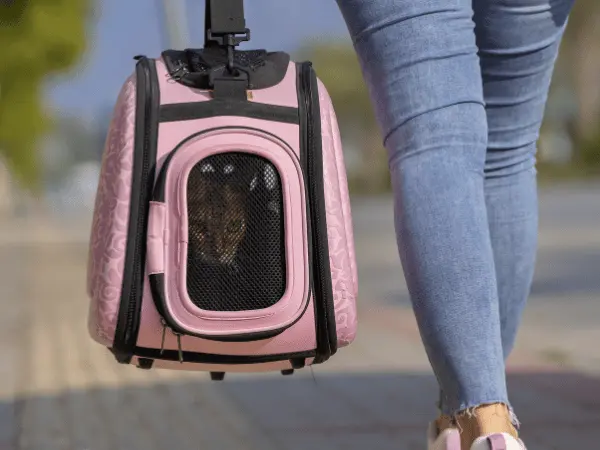
Are Cats Okay with Traveling?
All cats are different —- while some cats may be okay with traveling, some cats experience anxiety when traveling. This can be due to a lack of experience traveling or individual predispositions. In any scenario, it’s always best to consult a vet first! Aside from giving helpful tips on managing pet anxiety during travel, vets can also give personalized recommendations regarding required preventatives or managing pre-existing conditions.
In addition, having an appropriately sized cat carrier makes all the difference — whether traveling by car, plane, or any other means of transportation. Make sure to choose a cat carrier that is around 1.5 times your cat’s size, with just enough room to stand, turn around, and lie down.
I. How to Travel with a Cat to the Vet, Groomer, & Other Nearby Places
Whether driving or walking to a nearby vet clinic, groomer, or other establishment with your cat, the carrier will be your cat’s main source of security and safety. It is NOT ideal to travel with a cat on just a harness; this exposes them to danger and makes it more likely that they will run away.
A. The Best Cat Carrier for Short Trips
Though choosing the right carrier for short travels isn’t as strict as the guidelines on how to travel with a cat on a plane, the type of carrier you choose for short trips still makes a difference.
Both soft-sided and hard-sided carriers can work. However, if traveling with your cat for the first time, opt for a hard-sided carrier. If your cat is an experienced and calm traveler, soft-sided carriers are a more lightweight and easy-to-carry option.
B. Tips for a Relaxed Short Trip with Your Cat
So now that you have the right cat carrier, here are additional tips on how to travel with a cat for short distances:
- Be mindful of the carrier’s placement — When traveling with a cat by car, make sure that the carrier is fastened by a seatbelt in the backseat. It would also be ideal if your cat could still see you from where they are (i.e. diagonal to the driver’s seat).
- Drape a thin, breathable sheet over your cat’s carrier — this helps some cats feel hidden and secure, especially if you’re in a waiting room with other people and/or animals. Just make sure to get a fabric that does not interfere with the carrier’s ventilation.
- Choose a Fear Free vet or Fear Free establishment — both the journey and the destination matter for your cat. Even with the best efforts at keeping your cat calm during transit, if it leads to a stressful environment — your cat will eventually form a negative association. When you can, choose Fear Free!
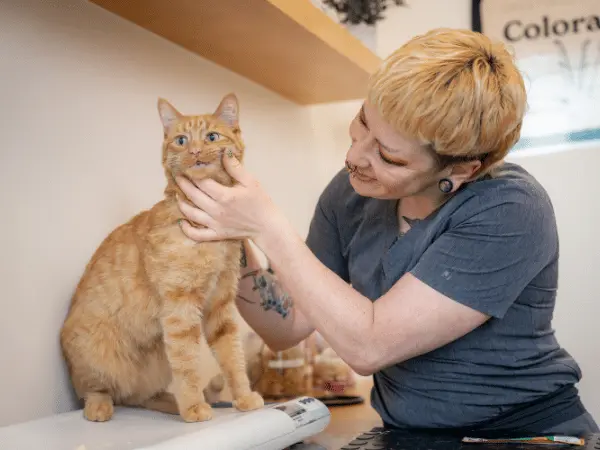
II. How to Travel with a Cat by Car [Road Trips]
Considering a long-distance drive with your cat? Whether you are moving or going on an extended stay somewhere else, ‘buckle up’ for some essential tips on how to travel with a cat by car:
A. The Best Cat Carrier for Long Car Rides
Though various kinds of carriers could be ideal, it is generally recommended to opt for a hard cat carrier for longer car rides as these tend to provide more protection. The main focus is car safety; we encourage pet parents to do their research into the safety features of a carrier before purchasing one. Some safety features to look for include impact protection and seat belt features.
B. Other Guidelines on How to Travel with a Cat By Car
- Have your cat microchipped — pet microchipping is generally beneficial and it is especially important when traveling with a cat over long distances. Microchips will be help reunite you with your pet in case of separation or if your ownership of your pet needs to be ascertained.
- Find out if you need a USDA pet health certificate — interstate travel may require a USDA pet health certificate, even if you travel by car with your cat. Make sure to research and plan ahead! Depending on where you’re going, your cat may also need additional vaccinations.
- Make sure your cat goes to the bathroom before your trip — this helps reduce the chances of bathroom accidents.
- Line the carrier with an absorbent pad — accidents can still happen even if your cat goes to the bathroom before the trip. Make sure to also bring replacement pads just in case.
- Bring a portable litter box — every time you pull over for a break or go to a rest stop, you can allow your cat to use their portable litter box. Keep your cat on a harness when taking them out of their carrier to use the litter box.
- Feed your cat a small amount before the trip — this helps prevent nausea.
- Bring a bottle of water for your cat — You can opt for a water bottle with a travel bowl for convenience. Some cats may also learn to use a pet water dispenser (hanging bottle), but you may need to train your cat before the trip. AVOID putting water in a dish as this might spill.
- Be mindful of the carrier’s placement — as mentioned earlier, there are two places in the car where you can put your cat: (1) the backseat diagonal to the driver’s seat and (2) the floor well behind the front passenger seat. Whichever you opt for, make sure that your cat’s carrier is leveled so that your cat can sit or lie down comfortably.
- NEVER let your cat out of the carrier while you are driving. This risks both your safety and your cat’s.
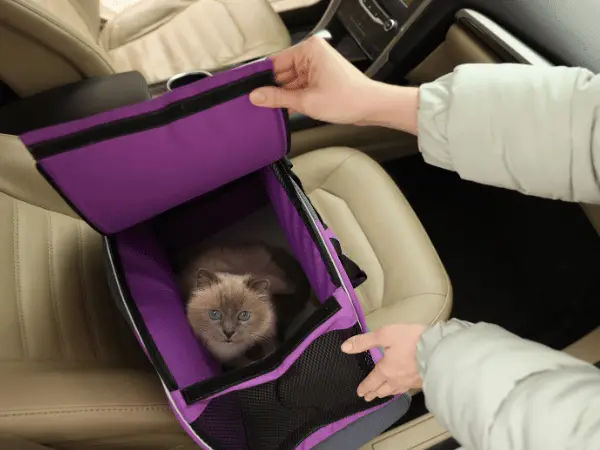
III. How to Travel with a Cat by Plane
Certain situations may require you to fly with your feline friend. We always recommend pet parents choose an airline that will allow your cat to fly in the cabin.
A. The Right Carrier for Traveling with a Cat by Plane
Once you’ve chosen an airline that will allow your cat to fly in the cabin, research their pet carrier requirements. Some airlines will recommend a certain size and type of carrier; some may also have carriers for sale. Always do your research in advance to prevent surprises at the airport.
B. Other Guidelines on How to Travel with a Cat by Plane
- Make sure that your chosen airline knows (in advance) that you’re flying with a pet — some airlines have restrictions on the number of pets that can fly.
- Find out if you need a USDA pet health certificate — whether traveling locally or internationally, this may be required paperwork. Depending on your destination, your cat may also need additional feline vaccinations and an ISO-certified pet microchip (for international travel.)
- Put a body harness on your cat — as you go through TSA’s screening process, you will be asked to remove your cat from the carrier as it goes through the X-ray. Make sure your cat is wearing a secure (but comfortable) body harness to prevent them from running away as you take them out.
- Feed your cat a small amount before the flight — this helps prevent nausea while flying and traveling to and from the airport.
- Make sure your cat goes to the bathroom before takeoff — this helps reduce the chances of bathroom accidents while on the plane. We recommend bringing a portable litter box, which you can set up in pet relief areas at the airport. It may be helpful to get your cat accustomed to using the portable litter box before your travel day.
- Line your cat carrier with an absorbent pad, have a replacement pad, & bring along a few emergency poop bags and antibacterial wipes — in case of accidents, having these items will help ensure that you can clean up your cat’s carrier and make your cat comfortable again.
- Know where to put your cat on a plane — when flying in the cabin, your cat will remain inside their carrier, placed under the seat in front of you.
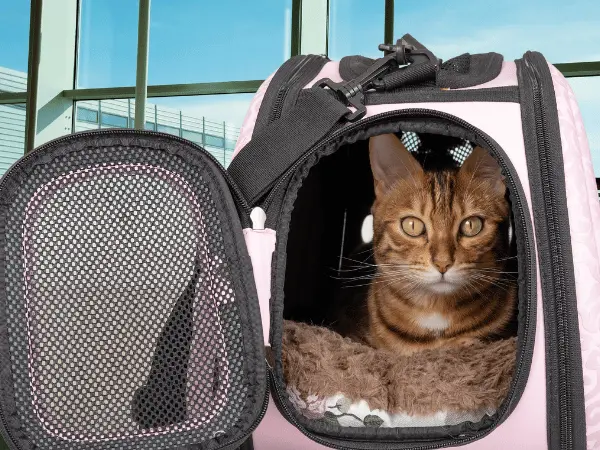
Final Thoughts on Traveling with a Cat
This wraps up our complete guide on traveling with a cat. By following the above tips, you can ensure a relaxed and comfortable trip with your feline companion.
As a reminder, make sure to schedule a vet visit before your planned trip, especially extended, interstate, or international trips. Getting the go signal from the vet is always beneficial; an experienced vet will also give you advice on calming your cat, strengthening your cat’s immunity for the trip, and getting started with any required paperwork.
Note: For some cats, veterinarians may recommend anti-anxiety medication to help reduce travel-related stress.
We’d also like to remind pet parents that traveling with a cat is not the only option. Aside from asking a trusted friend or family member to watch over your cat, you can also consider cat boarding establishments. Here are some examples of cat boarding services near Denver and Chicago:
Sploot Vets: A Fear Free Vet That Cats Love
Whether you have questions about your cat’s health or how to travel with a cat, we’re here to help. Sploot Vets is a Fear Free vet clinic in Chicago and Denver that provides preventative, urgent, and emergency vet services for cats and dogs.
Cats love our Fear Free methods, private exam rooms, and FREE treats! Book an appointment online or through out pet care app and experience next-level vet care for your cat.
Till next time, we’re with you every pounce of the way!
